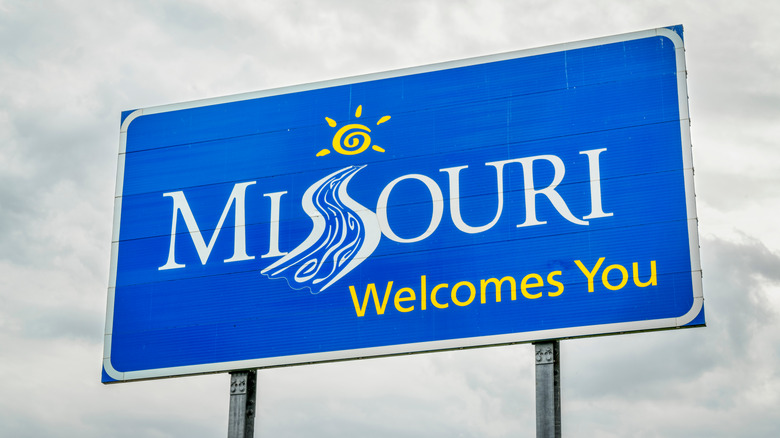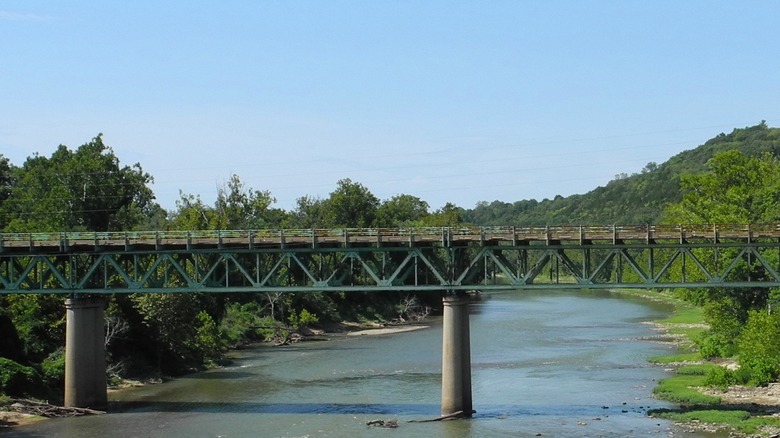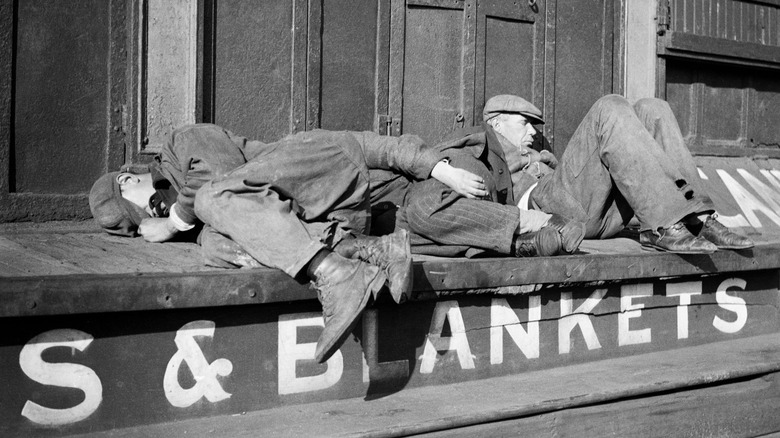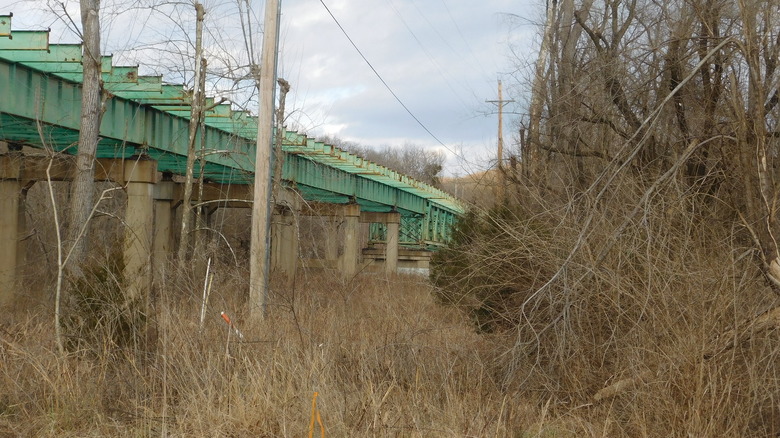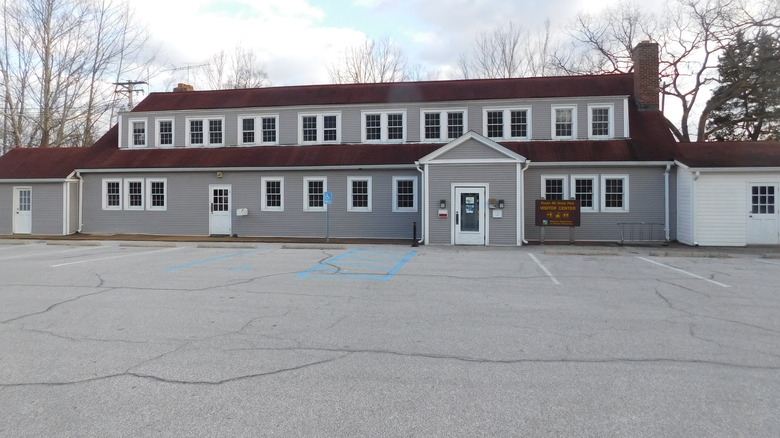The Tragic Reason A Missouri Town Was Evacuated And Then Completely Destroyed
The United States has its share of ghost towns. Some, like Bodie, California, enjoyed their heyday thanks to mining — gold in Bodie's case — but once the mines were depleted, the towns withered and died. You can still visit Bodie, and other towns just like it, to see its abandoned buildings frozen in time, as Interesting Engineering reported.
However, Times Beach, Missouri, is a ghost town that bears few similarities to others. It was nowhere near the Old West (although Missouri was once considered "The West," those days were long over by the time the town was founded). Its demise also had nothing to do with mining. And now, there's precious little left of Times Beach. Visitors to the site today will find a state park and a museum with the smallest of references to the small town, the people who lived there — and the reason they were forced to leave.
Summer homes on the river
The story of Times Beach began in 1925, according to St. Louis Magazine, when the now-defunct St. Louis Times newspaper began selling tracts of land as part of a subscription promotion. Specifically, the paper sold 6-month subscriptions for $67.50 in exchange for small lots about 15 miles from the western edge of the city. Now comfortably ensconced within the St. Louis exurbs, the town was once considered the middle of nowhere.
The lots were sold with a view toward the city's wealthy building summer homes there, in which they could escape the city for a comfortable retreat along the Meramec River (a tributary that empties into the Mississippi River a few miles downstream), perhaps while doing some fishing or boating. "The sweltering heat and discomfort of the city are unknown at Times Beach," touted a full-page newspaper advertisement in the Times. While that was a bit hyperbolic, the promotion was a success. The plots sold and the proud owners built homes on them.
Then came the Great Depression
For the people who purchased land and built homes there, the timing couldn't have been worse. Within a few years, the Great Depression hit, and few could afford summer homes. Some of those who already had purchased land at Times Beach and had built there tried to ride out the Depression there; St. Louis Magazine even described those times as "pastoral" for the townsfolk who, despite the hard times, enjoyed picnics, barbecues, and dancing.
Gas rationing during World War II put an end to all of that, however. Traveling to summer homes no longer made sense, if indeed it was possible at all. That turned Times Beach from a community of summer homes to a lower-middle-class rural town miles from anywhere, as Marilyn Leistner, the last mayor of the town, wrote in Synthesis/Regeneration. Still, the community was served by Route 66 — until Interstate 44 diverted traffic from the town.
Up until the early 1980s, Times Beach was not unlike a handful of other river towns in Missouri — rural, somewhat poor, and at risk of devastating floods.
There was a devastating flood
The people who live in river communities know that floods are a problem, and Times Beach was no exception. As Leistner wrote in Synthesis/Regeneration, many of the structures in the town were built on stilts, specifically so that when the Meramec flooded, they'd be protected from the floodwaters.
The final flood to bedevil Times Beach came in December of 1982. "On December 5, the community suffered the worst flood of its history. Many barely escaped with their lives. Flood stage was 18.5 feet and the water crested at 42.88 feet," the former mayor wrote.
Once again, however, the people of Times Beach found themselves the victims of bad timing. In fact, it would later be revealed that the terrible flooding was actually the least of the town's problems. Just a couple of months earlier, federal officials had begun the process of confirming that the town had been contaminated with a deadly chemical. The chemical contamination, and the resulting flood, would provide a one-two punch that effectively killed the town.
One of the worst environmental disasters in U.S. history
How a deadly chemical wound up on the streets of a Missouri town reads like a comedy of errors, except there's nothing funny about it.
As St. Louis Magazine reported, Russell Bliss, a local waste hauler, would often spray used motor oil on the town's unpaved streets, in order to control dust. Bliss would also use the process to control dust on his horse farm.
In fact, there was more than just motor oil. Bliss had actually taken on some industrial waste from a Missouri factory, some of which contained, among other contaminants, dioxin, a deadly poison. Bliss, who was neither trained nor licensed in the handling of toxic waste, would burn some of it. Some would be mixed with his existing barrels of used motor oil, and then sprayed on the city's streets.
"The roads had turned purple after being sprayed. The spraying had resulted in an awful odor. Birds had died and newborn animals succumbed shortly after their birth. One man remembered a dog found in one of the contaminated ditches," wrote the former mayor, via Synthesis/Regeneration.
The feds were less than helpful
Even as their town lay under dioxin-contaminated floodwaters during the winter of 1982, the residents of Times Beach were in a state of flux. When they began to suspect their town had been contaminated, the Environmental Protection Agency was unresponsive, telling residents the agency could possibly come to town and run tests — in a year or so, as St. Louis Magazine reported. Instead, the residents took up a collection to hire a private company to do the testing. That got the EPA's attention, and soon its own people were in town conducting tests.
It was during the worst of the flood that the town got the news its residents dreaded the most: it had, indeed, been contaminated by dioxin. And between the flood and the contamination, many residents were uninterested in coming back. Then they were told they couldn't come back if they wanted to. "On December 23, 1982, the residents received what we now call our Christmas message. 'If you are in town it is advisable for you to leave and if [you] are out of town do not go back.' Our community, virtually overnight, was transformed to a national symbol of something uninhabitable," wrote the former mayor in Synthesis/Regeneration.
If the people of Times Beach thought things couldn't possibly get any worse, they were wrong.
Things got worse
Flooded and contaminated, Times Beach was now uninhabitable. Fortunately, the Environmental Protection Agency had an account — a "superfund" — for just this purpose, buying out the homes of people forced to flee environmental disasters. Unfortunately, to say that the EPA lowballed the homeowners would be an understatement.
"The offers were very low, so we got organized. We would invite the press out, and we would spray-paint the prices [the EPA offered] on the homes," said Leistner, via St. Louis Magazine. Leistner even kept a photograph of one house, the EPA's offer of $15,800 sprayed on the side of the abandoned house.
Eventually, the federal bureaucracy loosened up a little bit, netting some residents slightly better offers for their homes, as well as relocation assistance. Most took it. By 1985, only one defiant couple remained in the town. "They wanted more money. [The woman] still blames me. I didn't set the price, but it's my fault. She doesn't speak to me," Leistner said.
Today there is almost nothing left of Times Beach
For decades, travelers along Interstate 44 through the St. Louis exurbs were largely unaware that just a few hundred yards away lay a decaying testament to one of the worst environmental disasters in U.S. history.
Travelers can still take an exit that will bring them to the former site of Times Beach. With cleanup completed, Missouri turned the area into the Route 66 State Park, according to the Missouri State Parks website. The attraction is anchored by a visitor's center and museum, pictured above, which at one time was a Route 66 roadhouse, a remnant of the town's "glory days," as St. Louis Magazine reported. And though the park leans heavily into its Route 66 heritage, it does offer up a tiny nod to the misery that happened there — a single Times-Beach-themed exhibit in a corner of the building. St. Louis Magazine writer William Powell noted that the exhibit, surrounded by tourist tchotchkes, "can feel a little disrespectful."
